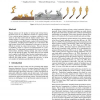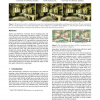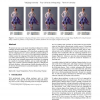107
Voted
SIGGRAPH
2010
ACM
15 years 5 months ago
2010
ACM
This paper introduces an approach to control of physics-based characters based on high-level features of movement, such as centerof-mass, angular momentum, and end-effectors. Obje...
123
click to vote
SIGGRAPH
2010
ACM
15 years 5 months ago
2010
ACM
Human motions are the product of internal and external forces, but these forces are very difficult to measure in a general setting. Given a motion capture trajectory, we propose ...
114
click to vote
SIGGRAPH
2010
ACM
15 years 5 months ago
2010
ACM
Painters and illustrators commonly sketch vanishing points and lines to guide the construction of perspective images. We present a tool that gives users the ability to manipulate ...
SIGGRAPH
2010
ACM
15 years 5 months ago
2010
ACM
We present an easy-to-use image retouching technique for realistic reshaping of human bodies in a single image. A model-based approach is taken by integrating a 3D whole-body morp...
189
Voted
SIGGRAPH
2010
ACM
15 years 5 months ago
2010
ACM
Traditional image compositing techniques, such as alpha matting and gradient domain compositing, are used to create composites that have plausible boundaries. But when applied to ...
112
click to vote
SIGGRAPH
2010
ACM
15 years 5 months ago
2010
ACM
We present a method for inferring the behavior styles of character controllers from a small set of examples. We show that a rich set of behavior variations can be captured by dete...
106
Voted
SIGGRAPH
2010
ACM
15 years 5 months ago
2010
ACM
We present a method for parameterizing subdivision surfaces in an as-rigid-as-possible fashion. While much work has concentrated on parameterizing polygon meshes, little if any wo...
101
click to vote
SIGGRAPH
2010
ACM
15 years 5 months ago
2010
ACM
High-order and regularly sampled surface representations are more efficient and compact than general meshes and considerably simplify many geometric modeling and processing algor...
88
Voted
SIGGRAPH
2010
ACM
15 years 5 months ago
2010
ACM
We present a continuum-based discrete model for thin threads of viscous fluid by drawing upon the Rayleigh analogy to elastic rods, demonstrating canonical coiling, folding, and ...
104
click to vote
SIGGRAPH
2010
ACM
15 years 5 months ago
2010
ACM
Simulating fluids based on vortex filaments is highly attractive for the creation of special effects because it gives artists full control over the simulation using familiar too...



